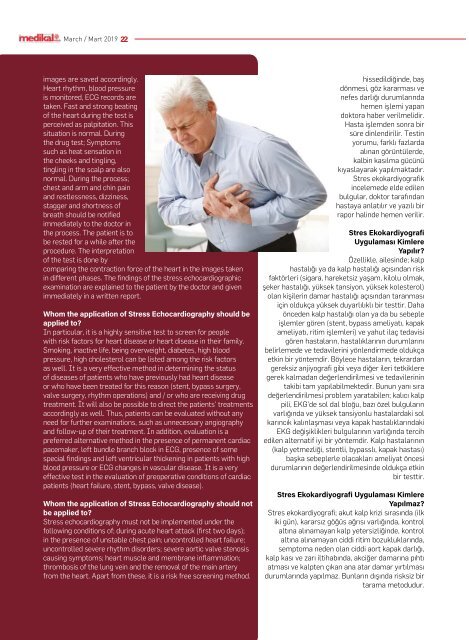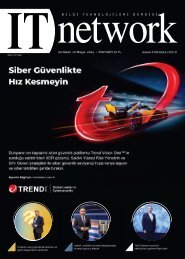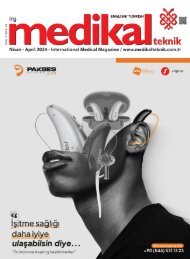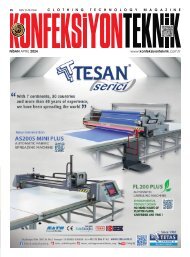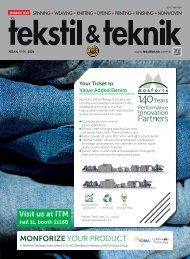Medikal Teknik Mart 2019
Medikal Teknik Mart 2019
Medikal Teknik Mart 2019
Create successful ePaper yourself
Turn your PDF publications into a flip-book with our unique Google optimized e-Paper software.
March / <strong>Mart</strong> <strong>2019</strong> 22<br />
images are saved accordingly.<br />
Heart rhythm, blood pressure<br />
is monitored, ECG records are<br />
taken. Fast and strong beating<br />
of the heart during the test is<br />
perceived as palpitation. This<br />
situation is normal. During<br />
the drug test; Symptoms<br />
such as heat sensation in<br />
the cheeks and tingling,<br />
tingling in the scalp are also<br />
normal. During the process;<br />
chest and arm and chin pain<br />
and restlessness, dizziness,<br />
stagger and shortness of<br />
breath should be notified<br />
immediately to the doctor in<br />
the process. The patient is to<br />
be rested for a while after the<br />
procedure. The interpretation<br />
of the test is done by<br />
comparing the contraction force of the heart in the images taken<br />
in different phases. The findings of the stress echocardiographic<br />
examination are explained to the patient by the doctor and given<br />
immediately in a written report.<br />
Whom the application of Stress Echocardiography should be<br />
applied to?<br />
In particular, it is a highly sensitive test to screen for people<br />
with risk factors for heart disease or heart disease in their family.<br />
Smoking, inactive life, being overweight, diabetes, high blood<br />
pressure, high cholesterol can be listed among the risk factors<br />
as well. It is a very effective method in determining the status<br />
of diseases of patients who have previously had heart disease<br />
or who have been treated for this reason (stent, bypass surgery,<br />
valve surgery, rhythm operations) and / or who are receiving drug<br />
treatment. İt will also be possible to direct the patients’ treatments<br />
accordingly as well. Thus, patients can be evaluated without any<br />
need for further examinations, such as unnecessary angiography<br />
and follow-up of their treatment. In addition, evaluation is a<br />
preferred alternative method in the presence of permanent cardiac<br />
pacemaker, left bundle branch block in ECG, presence of some<br />
special findings and left ventricular thickening in patients with high<br />
blood pressure or ECG changes in vascular disease. It is a very<br />
effective test in the evaluation of preoperative conditions of cardiac<br />
patients (heart failure, stent, bypass, valve disease).<br />
Whom the application of Stress Echocardiography should not<br />
be applied to?<br />
Stress echocardiography must not be implemented under the<br />
following conditions of; during acute heart attack (first two days);<br />
in the presence of unstable chest pain; uncontrolled heart failure;<br />
uncontrolled severe rhythm disorders; severe aortic valve stenosis<br />
causing symptoms; heart muscle and membrane inflammation;<br />
thrombosis of the lung vein and the removal of the main artery<br />
from the heart. Apart from these, it is a risk free screening method.<br />
hissedildiğinde, baş<br />
dönmesi, göz kararması ve<br />
nefes darlığı durumlarında<br />
hemen işlemi yapan<br />
doktora haber verilmelidir.<br />
Hasta işlemden sonra bir<br />
süre dinlendirilir. Testin<br />
yorumu, farklı fazlarda<br />
alınan görüntülerde,<br />
kalbin kasılma gücünü<br />
kıyaslayarak yapılmaktadır.<br />
Stres ekokardiyografik<br />
incelemede elde edilen<br />
bulgular, doktor tarafından<br />
hastaya anlatılır ve yazılı bir<br />
rapor halinde hemen verilir.<br />
Stres Ekokardiyografi<br />
Uygulaması Kimlere<br />
Yapılır?<br />
Özellikle, ailesinde; kalp<br />
hastalığı ya da kalp hastalığı açısından risk<br />
faktörleri (sigara, hareketsiz yaşam, kilolu olmak,<br />
şeker hastalığı, yüksek tansiyon, yüksek kolesterol)<br />
olan kişilerin damar hastalığı açısından taranması<br />
için oldukça yüksek duyarlılıklı bir testtir. Daha<br />
önceden kalp hastalığı olan ya da bu sebeple<br />
işlemler gören (stent, bypass ameliyatı, kapak<br />
ameliyatı, ritim işlemleri) ve yahut ilaç tedavisi<br />
gören hastaların, hastalıklarının durumlarını<br />
belirlemede ve tedavilerini yönlendirmede oldukça<br />
etkin bir yöntemdir. Böylece hastaların, tekrardan<br />
gereksiz anjiyografi gibi veya diğer ileri tetkiklere<br />
gerek kalmadan değerlendirilmesi ve tedavilerinin<br />
takibi tam yapılabilmektedir. Bunun yanı sıra<br />
değerlendirilmesi problem yaratabilen; kalıcı kalp<br />
pili, EKG’de sol dal bloğu, bazı özel bulguların<br />
varlığında ve yüksek tansiyonlu hastalardaki sol<br />
karıncık kalınlaşması veya kapak hastalıklarındaki<br />
EKG değişiklikleri bulgularının varlığında tercih<br />
edilen alternatif iyi bir yöntemdir. Kalp hastalarının<br />
(kalp yetmezliği, stentli, bypasslı, kapak hastası)<br />
başka sebeplerle olacakları ameliyat öncesi<br />
durumlarının değerlendirilmesinde oldukça etkin<br />
bir testtir.<br />
Stres Ekokardiyografi Uygulaması Kimlere<br />
Yapılmaz?<br />
Stres ekokardiyografi; akut kalp krizi sırasında (ilk<br />
iki gün), kararsız göğüs ağrısı varlığında, kontrol<br />
altına alınamayan kalp yetersizliğinde, kontrol<br />
altına alınamayan ciddi ritim bozukluklarında,<br />
semptoma neden olan ciddi aort kapak darlığı,<br />
kalp kası ve zarı iltihabında, akciğer damarına pıhtı<br />
atması ve kalpten çıkan ana atar damar yırtılması<br />
durumlarında yapılmaz. Bunların dışında risksiz bir<br />
tarama metodudur.


